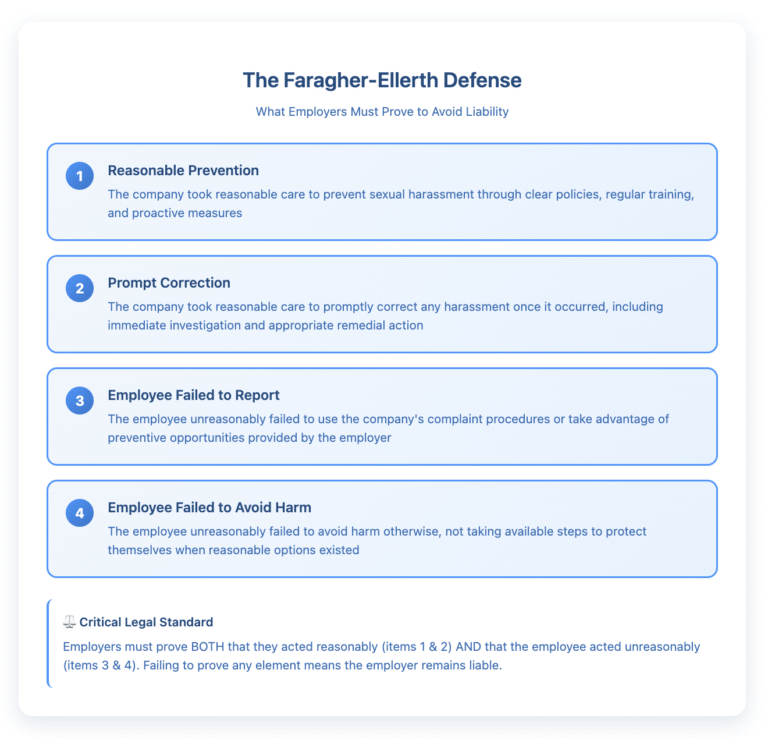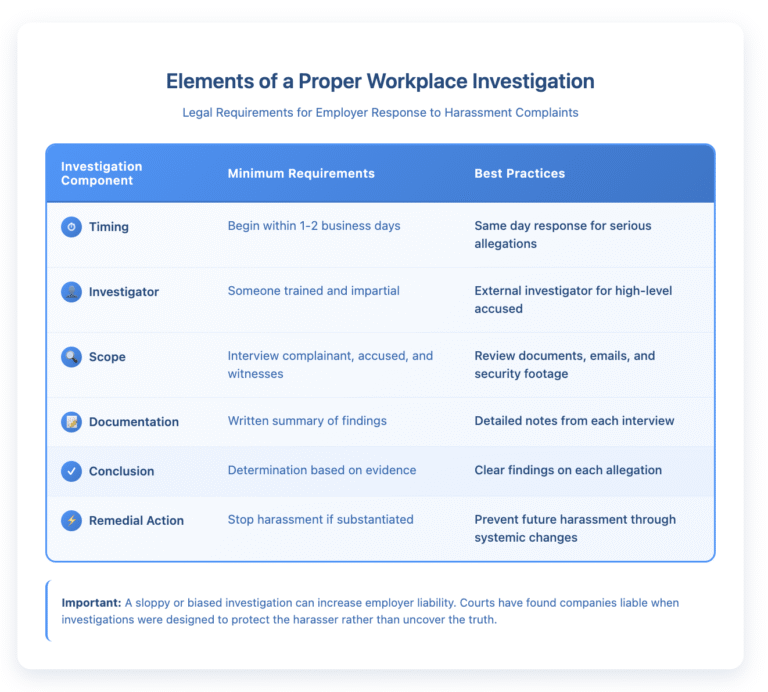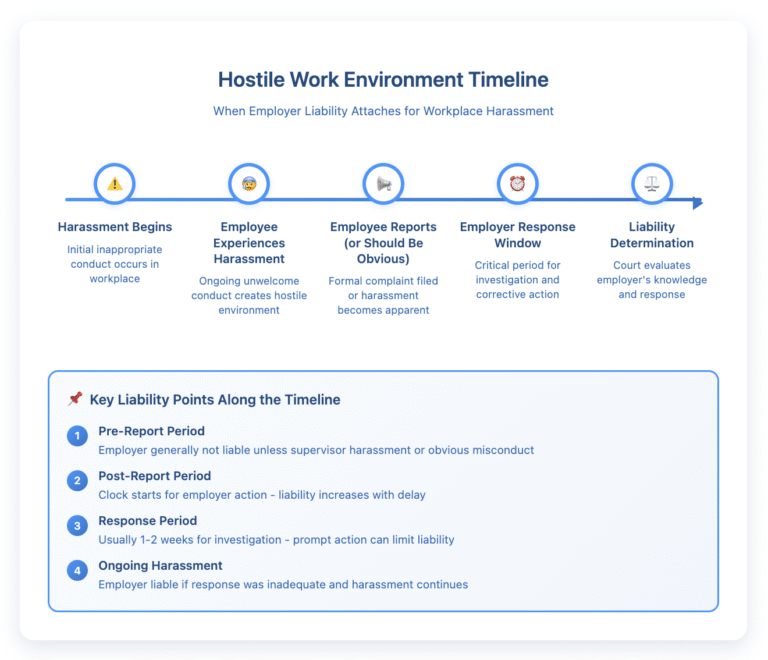If you’re dealing with sexual harassment at work, one of the most important questions you need answered is this: Can I hold my employer legally responsible? The answer isn’t always straightforward, but understanding when companies are liable for workplace harassment can make the difference between a successful claim and one that goes nowhere.
Here’s what you need to know: employers aren’t automatically responsible for every instance of sexual harassment that happens in their workplace. The law has created specific standards that determine when a company must answer for the misconduct happening under its roof. Let’s break down exactly when your employer can be held accountable.
Disclaimer: This article provides general information for informational purposes only and should not be considered a substitute for legal advice. It is essential to consult with an experienced employment lawyer at our law firm to discuss the specific facts of your case and understand your legal rights and options. This information does not create an attorney-client relationship.
The Two Critical Factors That Determine Employer Liability
When courts evaluate whether an employer is liable for sexual harassment, they look at two main factors: who did the harassing and what the company knew (or should have known) about it.
The harasser’s position in the company matters enormously. If your supervisor sexually harassed you, the legal standards are completely different than if a coworker did it. This distinction exists because supervisors have power over your job – they can fire you, demote you, change your schedule, or affect your career in countless ways. Coworkers, while they can certainly create hostile environments, don’t have that same institutional power.
Understanding Supervisor Harassment Liability
When a supervisor sexually harasses an employee, employers face what’s called “vicarious liability.” This means the company is responsible for the supervisor’s actions because that supervisor is acting as an agent of the company.
If a supervisor’s harassment results in a “tangible employment action” – like firing you, demoting you, or significantly changing your responsibilities – your employer is automatically liable. No exceptions. It doesn’t matter if the company had the best anti-harassment policy in the world or if they had no idea the harassment was happening.
The Faragher-Ellerth Defense: When Employers Can Escape Liability
But what if the supervisor harassment didn’t result in you losing your job or getting demoted? What if they “just” created a hostile work environment? This is where things get more complex.
In cases where supervisor harassment doesn’t lead to a tangible employment action, employers can potentially avoid liability by proving what’s known as the Faragher-Ellerth defense (named after two Supreme Court cases: Faragher v. City of Boca Raton and Burlington Industries, Inc. v. Ellerth).

Here’s the crucial part: the employer must prove both that they acted reasonably AND that you acted unreasonably. If they can’t prove both parts, they lose this defense and remain liable.
Coworker Harassment: A Different Standard
When the harassment comes from a coworker rather than a supervisor, the liability rules change significantly. For coworker harassment, your employer is only liable if they were negligent – meaning they knew or should have known about the harassment and failed to take prompt, appropriate action.
This creates a higher bar for holding employers accountable. You’ll need to show that management was aware of the problem (or that it was so obvious they should have been aware) and that they didn’t respond adequately.
What Makes an Employer “Negligent” in Coworker Cases?
Think of it this way: once an employer knows about coworker harassment, the clock starts ticking. They need to investigate promptly, take the complaint seriously, and implement appropriate remedies. If they drag their feet, conduct a sham investigation, or take ineffective action, they can be held liable.
Red flags that suggest employer negligence include:
- Ignoring multiple complaints about the same harasser
- Conducting superficial investigations that don’t interview key witnesses
- Taking months to respond to a harassment complaint
- Implementing “remedies” that don’t actually stop the harassment
- Retaliating against employees who report harassment
The Customer and Client Harassment Loophole
Here’s something that might surprise you: your employer can also be liable for sexual harassment by non-employees like customers, clients, or vendors. The standard is similar to coworker harassment – the employer must know or should have known about the harassment and failed to take appropriate action.
For example, if you work in retail and a regular customer repeatedly makes sexual comments to you, your employer can’t just shrug and say “that’s not our employee, so it’s not our problem.” Once you report it, they need to take action – whether that’s banning the customer, changing your schedule, or finding another solution.
Real-World Applications: How Courts Apply These Standards
Let’s look at how these principles play out in actual cases. In Vance v. Ball State University (2013), the Supreme Court clarified who counts as a “supervisor” for harassment liability purposes. The Court held that an employee is a supervisor only if they have the power to take tangible employment actions against the victim. This means that team leads or shift supervisors who can’t actually fire or demote you might be treated as coworkers for liability purposes, even if they direct your daily work.
In Pennsylvania State Police v. Suders (2004), the Supreme Court addressed what happens when an employee resigns due to harassment. The Court held that if harassment is so intolerable that resignation is a fitting response, it counts as a tangible employment action – meaning the employer faces strict liability without the possibility of the Faragher-Ellerth defense.
The Investigation Obligation: What Employers Must Do
Once an employer receives a harassment complaint, they have a legal duty to investigate. This isn’t optional – it’s a requirement. But not all investigations are created equal.

A sloppy or biased investigation can actually make things worse for an employer. Courts have found companies liable when their investigations were clearly designed to protect the harasser rather than uncover the truth.
The Notice Requirement: When Should Employers Have Known?
You don’t always have to formally report harassment for your employer to be on notice. Courts recognize that employers can have “constructive knowledge” – meaning the harassment was so open and obvious that management should have known about it.
Examples of constructive knowledge include:
- Harassment is happening openly in common areas
- Sexual materials posted in workspaces
- Multiple employees are discussing the harassment
- Previous similar complaints about the same person
- Harassment witnessed by lower-level supervisors
However, if the harassment is truly hidden and you never reported it, it’s much harder to hold the employer liable, especially for coworker harassment.
Special Circumstances That Affect Liability
Several factors can strengthen or weaken an employer’s liability for sexual harassment:
Factors That Increase Employer Liability
Pattern of harassment: If multiple employees have complained about the same harasser, employers face higher liability for failing to act.
Retaliation: If an employer retaliates against someone for reporting harassment, it often eliminates any defense they might have had.
Inadequate policies: Having no sexual harassment policy, or having one that’s unclear or hard to use, makes it harder for employers to avoid liability.
Company culture: Evidence that management tolerated or participated in inappropriate sexual conduct can establish liability even without formal complaints.
Factors That May Reduce Employer Liability
Prompt, effective action: Employers who immediately investigate and stop harassment may avoid liability, especially in coworker cases.
Clear, accessible policies: Having well-publicized, easy-to-use complaint procedures helps employers establish the Faragher-Ellerth defense.
Regular training: Conducting regular, meaningful harassment prevention training shows the employer takes prevention seriously.
The Hostile Work Environment Timeline
Understanding when an employer becomes liable for a hostile work environment requires looking at the timeline of events:

The longer an employer takes to respond after notice, the more likely they’ll be found liable. Courts expect employers to treat harassment complaints with urgency.
Small Employer Exceptions and Limitations
If your employer has fewer than 15 employees, Title VII (the federal law prohibiting sexual harassment) doesn’t apply. However, many states have laws covering smaller employers. New York, for instance, covers all employers regardless of size for sexual harassment claims.
Small employers sometimes argue they lack the resources for extensive investigations or HR departments. While courts may consider company size in evaluating reasonableness, it doesn’t excuse employers from their basic obligation to address harassment.
Documentation That Strengthens Employer Liability Claims
To prove employer liability, documentation is crucial. The strongest evidence includes:
- Written complaints to HR or management (emails, letters, complaint forms)
- Responses (or lack thereof) from the employer
- Timeline showing the delay between the complaint and the action
- Evidence of similar complaints by others
- Witness statements about what management knew
- Company policies and whether they were followed
- Investigation files showing inadequate response
Recent Legal Developments Affecting Employer Liability
The legal landscape for employer liability continues evolving. The #MeToo movement has led to significant changes in how courts and juries view employer responsibility for sexual harassment.
Many states have recently expanded employer liability. New York’s 2019 amendments eliminated the “severe or pervasive” standard for harassment claims, making it easier to hold employers accountable. California extended the statute of limitations for filing harassment claims and limited the use of non-disclosure agreements.
Federal courts have also shown less tolerance for employer inaction. Recent decisions have found liability where employers conducted “check-the-box” investigations without real intent to uncover or stop harassment.
What This Means for Your Harassment Claim
Understanding employer liability helps you evaluate the strength of your potential claim. If your supervisor harassed you and took any negative job action against you, you likely have a strong case for employer liability. If a coworker harassed you, your case depends more on what the company knew and how they responded.
The key is documentation and timing. Report harassment as soon as possible, in writing, following your company’s procedures. If your employer doesn’t have clear procedures, report it to HR or management anyway and keep copies of everything.
Taking Action: Your Next Steps
If you’re experiencing sexual harassment at work, knowing your employer can be held liable is just the beginning. You need to:
- Document everything – dates, times, witnesses, and impacts on your work
- Report the harassment – use company procedures if they exist, but don’t let a lack of procedures stop you
- Keep reporting – if the harassment continues, keep complaining and documenting
- Know your deadlines – EEOC charges must be filed within 180 or 300 days, depending on your state
- Get legal help – an experienced attorney can evaluate whether your employer can be held liable
Don't Wait to Get Help
Employer liability for sexual harassment is complex, but you don’t have to figure it out alone. The specific facts of your situation – who harassed you, what your employer knew, and how they responded – determine whether you can hold your company accountable.
At Nisar Law Group, we help employees understand their rights and hold employers accountable for sexual harassment. We’ll review your situation, explain how liability standards apply to your case, and help you pursue the justice you deserve. Contact us today for a consultation to discuss your sexual harassment claim and learn how we can help protect your rights and career.


